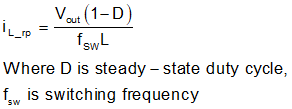SLUAA12 March 2020 TPS53681
- Selection Considerations for Output Capacitors of Multiphase Voltage Regulators Part 1
3.1 Steady-state Output Ripple
Steady-state output voltage ripple is a function of capacitance, capacitor equivalent series resistance (ESR), and inductor ripple current. In multiphase applications, effective inductor current ripple is used to calculate Vout ripple, not per phase current ripple.
For single phase application, inductor current ripple:

In multiphase application, in most of the cases, voltage drop ratio is high and not particular many phases are used for interleaving, as there are no overlaps between any two PWM waveforms of each phase, the effective ripple of Isum:

If effective ESR and ESL are neglected, the output voltage ripple is as follow:

But in most of the cases, the output capacitance should be decided by load transient specification.